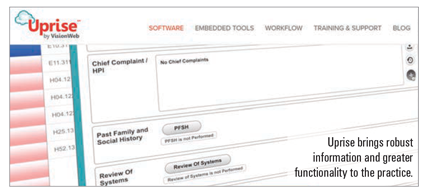

She had been eyeing Uprise practice management and EHR but hadn’t made the conversion yet because shifting from one system to another takes concentrated effort. In addition, she knew she would be running two systems side by side for a while. She would not upload all of the patient data for the past two decades into the new software. “I knew I would be building a robust history going forward, but I wouldn’t have the historical past unless I ran systems side by side,” she says.
Stay-home orders became a great opportunity to get herself and the staff used to the new system. “I could put my staff through the training and we could learn the system while staying at home,” she says.
Once it was set up, staff members—who were being paid to work at home with funding from the Paycheck Protection Program—were able to watch onboarding videos and learn how to utilize the new insurance features. “Uploading insurance is far easier than with our previous software,” she says.
The more relaxed pace of learning the software and the reduced patient flow mandated by local ordinances helped when the practice reopened to routine care in early May. “With the lower-than-usual patient volume, we have some downtime to work on the conversion more,” she says. The practice purposefully added lots of breaks into the daily schedule, knowing that team members would need time to adjust to new safety measures and social distancing.
RELIABLE SYSTEM IS CRITICAL
Dr. Szabo says the COVID-19 closing demonstrated just how essential a reliable software system is. “Patients have the ability to fill out their paperwork in the patient portal. That means my staff isn’t filling it in, which minimizes the time the patient is in the office and increases our efficiency,” she says.


She sees advantages in the near term and in case of other office closings—which could be as simple as weather-related short-term closings or future regional or larger viral outbreaks. It could provide her with easier access to patient records so that she could have telemedicine consults, or her staff can order contact lenses or replacement emergency eyewear for patients. “It’s been a tough couple of years in Texas with Hurricane Harvey and floods, so exploring ways to make telemedicine work for some patient visits is smart,” she says.
Uprise would help because it’s so easy to access documents and have patients upload information. With her previous system, patient documents or images emailed were loaded to one server and from there, she’d have to email them to another system, download the images, open the patient’s chart and add them. “With Uprise, I can take a picture of the eyes and upload it into a patient’s file with one step,” she says. Having access to those images is important to be able to get as much clinical data as possible for telemedicine consults. “I’ve had patients tell me that their eyes are in so much pain with severe burning, but the photo shows the eye is white. So then I can begin to think the discomfort is more likely from light sensitivity or exposure, which is obviously a different treatment protocol from acute infection.
“This is a seamless, cloud-based system, and there are no differences based on the device, so it’s very easy to go from computer to tablet.”
It could also help her with managing her second office. “Sometimes I struggle keeping them both staffed. I see Uprise as providing more robust information and being a way to cover that second location if my associate has to be off for a period of time. A technician there can take an optomap image, and I can speak to the patient and document that to determine the next steps,” she says.
INFORMATION AT THE READY
For now, she sees that its powerful features will help improve office efficiencies immediately. “It helps us with the billing and coding, alerting us before we send it off if something in our coding doesn’t meet the rules for that code. Those rules change so frequently, it’s very difficult to keep up with that manually,” she says.
That’s important as she recently went through a staff restructuring when she began using VisionWeb for billing. Now, it’s easier to transmit the information online through Uprise to VisionWeb.
The system also provides her with access to availability databases for contact lenses, confirming that the lens she wants is available in the parameters she needs. It has similar capabilities for frame availability, colors and sizes.
“I had been wanting to make the move to Uprise for a while, but I was putting off the growing pains to make the move. This downtime presented me with the opportunity to make this switch.”
LEARN MORE
Click here to learn more about the robust EHR software Dr. Szabo uses in her practice.



